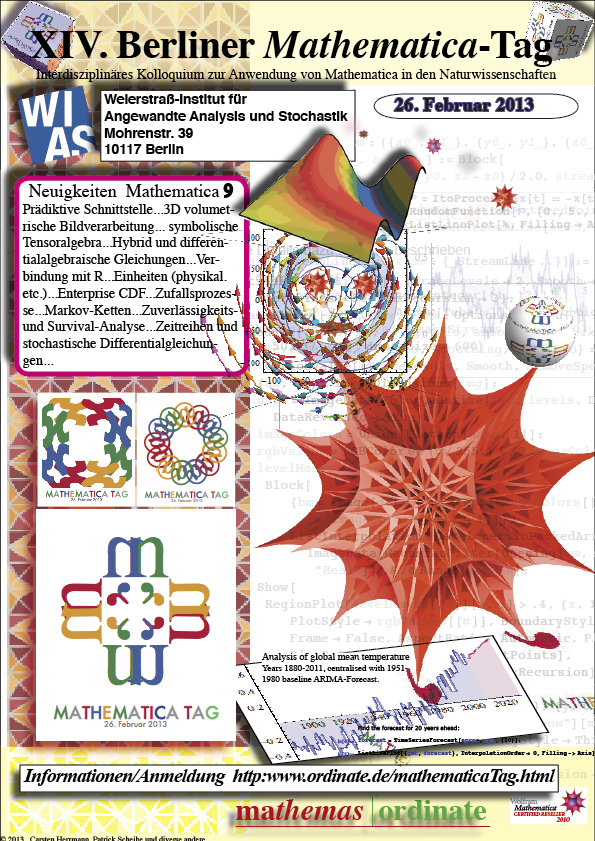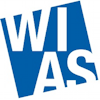 Der XIV. Mathematica-Tag Der XIV. Mathematica-Tag
 Berlin - 26.2.2013, 9:15-ca. 16:00 Berlin - 26.2.2013, 9:15-ca. 16:00
Ort: WIAS Berlin, U-Bahn Hausvogteiplatz, Erhard-Schmidt-Hörsaal (Eingang Mohrenstrasse 39)
Poster runterladen, ausdrucken und aufhängen !
Programm - Änderungen auch kurzfristig vorbehalten
9.15 Begrüssung
9.30 Dr. Leonid Shifrin, St. Petersburg:
RLink: linking Mathematica and R
R is a programming language and software environment for statistical computing and graphics. It is an open source project, available on all major platforms, and has become widely popular in the statistical community. RLink is a Mathematica application that connects Mathematica and R, and is a part of Mathematica version 9 distribution. It allows Mathematica users to communicate the data between Mathematica and R, and execute R code from within Mathematica.
In this talk, we will illustrate its capabilities, and show how it can empower Mathematica users by giving them seamless access to the entire R functionality, and R users, who can use Mathematica as a complement and powerful interactive development environment for R.
10.30 Carsten Herrmann, Survival und Reliability
German talk with english notebook: Survival and reliability are two (actually one) new fields covered by Mathematica 9. The talk will give a short introduction to this statistical field as well as the new Mathematica functions devoted to it.
11.00 Dr. Rolf Mertig, Gluon Vision: Details and notes about CDF Enterprise 9.0
An overview of the technical differences between free CDF and CDF Enterprise is given.
Several worked-out examples are given. Special focus is put on security of CDF's produced by Mathematica Enterprise.
Best practices of how to encode your own code in a CDF are given. An integration with web Mathematica is also presented.
Business opportunities are sketched.
11.30 Prof. Dr. Rolf Sulanke:
Tensoralgebra mit Mathematica
I have finished a Mathematica notebook "Vector and Tensor Algebra" and the package tensalg.m needed to work with the notebook. Besides of elementary vector algebra the notebook contains a complete tensor algebra as a part of affine geometry. In Mathematica there doesn't exist a built-in Tensor definition, but some tensor operations, like e.g. TensorProduct are built-in. In the notebook I define a symbolic tensor object which admits to introduce covariant, contravariant and mixed type tensors. The concept can be used for symbolic calculations as well as for calculations with tensors whose components are numerically or functionally specified. Tensor products, the wedge product as the base of exterior algebra, and contraction of tensors are introduced. Their properties are deduced and compared with those of the corresponding Mathematica built-in tensor functions. Since also in the commercial packages of Harald H. Soleng, Tensors in Physics, and Steven M. Christensen, MathTensor, an abstract tensor concept is missing I hope that the notebook and the package presented here fill an essential gape in Mathematica.
12.15 Imbiss-Pause (Spende von mathemas ordinate, bereitet von WIAS)
13.15 Dr. Markus von Almsick, Wolfram Research
Eine Mathematica Version 9 Safari
"Die im November 2012 erschienene Mathematica Version 9 umfasst über 400 neue Features.
Der Vortrag stellt eine Safari durch den Dschungel dieser Neuerungen dar. Anhand von Beispielen
werden wir die Tragweite der neuen Konzepte in der Statistik und Stochastik, der Bild- und Signalverarbeitung, dem User-Interface und bei Differentialgleichungen beleuchten und diskutieren."
14.15 Jörg Polzehl (WIAS Berlin)
Image processing with structural adaptive smoothing
We illustrate the capabilities of the structural adaptive smoothing approach developed at WIAS. Imaging processing tools of Mathematica
are used for comparisons. A short overview on applications of structural adaptive smoothing methods to medical imaging problems
is given.
14.30 Patrick Scheibe,
Translationszentrum für regenerative Medizin, Universität Leipzig:
1) Tweaking the Autocompletion of Mathematica
Verbesserung der Autocompletion in Mathematica
Changes the behavior of the autocompletion in Mathematica version 9 so that CamelCase completion can be used. CamelCase allows not only for the expansion of prefixes like Integ for IntegerDigits, it allows additionally to specify the capital letters (the humps) in function names only and therefore, e.g. ListLiPlo, ListLPlot or even LLP can be expanded to ListLinePlot.
2) Technische Fragen und Antworten (Q&A)
Anschliessend Kaffee und Ausklang
Bei Fragen : carstenAtOrdinateDE oder Tel.: 0431 2374500 oder 0177 3128557
|
